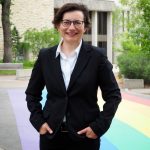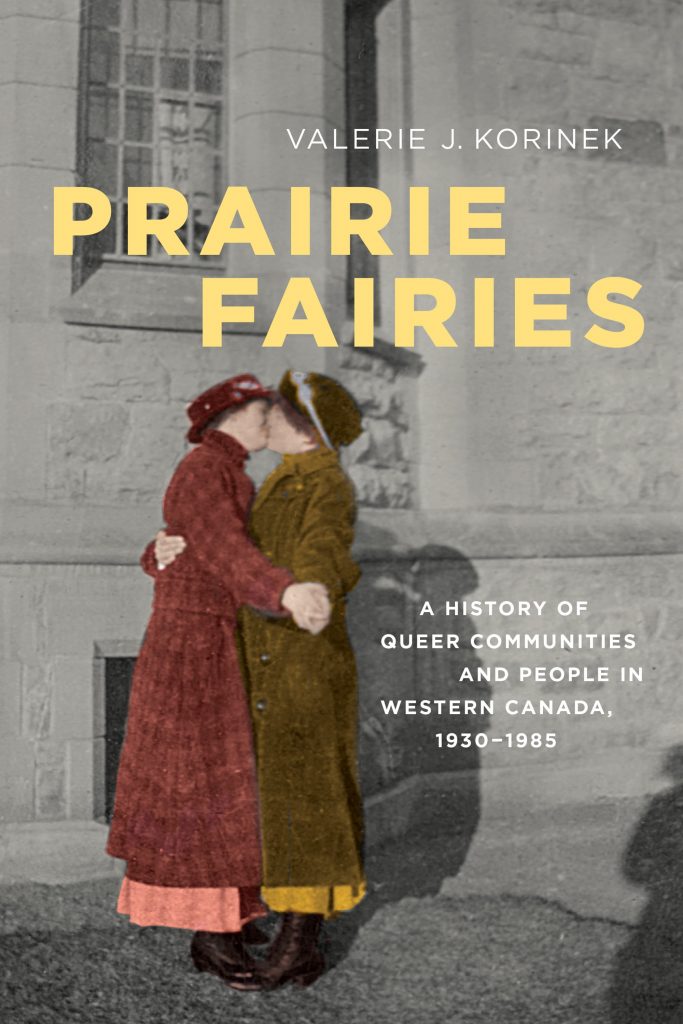Valerie Korinek
Prairie Fairies is about the history of queer community formation in the Canadian prairies in two eras. The first era, from the 1930s-1970 explores the pre-organizational phase, where queer people carved out strategies to live their lives that involved subterranean worlds in mixed bars, cruising spaces, tea rooms, restaurants and diners, and house parties. The second phase, beginning in 1970, follows the establishment of dedicated gay and lesbian spaces in the cities—for socializing, cultural production and activism. This was a vibrant world, people in the prairies were resourceful and engaging in national and international currents of queer activism and culture but chose to stay in their home region and adapt those experiences to western Canadian realities.
NOTCHES: What drew you to this topic, and what questions do you still have?
Korinek: I was drawn to this topic because of a huge wealth of resources—the Neil Richards Collection of archival documents, held at the Provincial Archives of Saskatchewan, and the University of Saskatchewan Archives and Special Collections. Mr. Richards was an activist and historian, working at the U of S library, who kept and then donated this terrific collection to the province and campus. He was instrumental in alerting me to the rich history that was held in those archival boxes, and from there, I begin to search out other regional archives, and to undertake oral interviews with narrators in each of the five cities. This project, initially conceived as a “small” research project, took on a life of its own and became far larger than intended because of the vast resources that existed and because queer histories had very, very little written about them. The questions that remain, for me, are those that focus on the period, post 1985, when my book concludes, with the start of AIDS activism, which forever changed activism and community organization in the cities.
NOTCHES: This book is clearly about the history of sex and sexuality, but what other themes does it speak to?
Korinek: This book speaks to important themes, transnationally, in queer histories. Notably it engages with the urban histories of queer life, claiming space for prairie cities amongst the earlier, influential work on major queer cities, such as New York, London and San Francisco. That was a stepping off point for the research and study — how was it different being gay or lesbian in these five western Canadian cities? Unlike previous work, this is a regional study, which allowed for much focus on migration and travel, amongst and between small towns, the north, farms and cities. Queer people were and are highly mobile, and taking a regional approach really shed light on how people migrated to prairie cities from small towns and rural areas. It speaks to activist histories, notably queer, but also feminist struggles for “liberation”, recognition, and later, various campaigns for human rights and recognitions.
NOTCHES: How did you research the book and what sources did you use?
Korinek: This book, as mentioned above, draws on three major groups of documents: archival materials from throughout the region, as well as the Canadian Lesbian and Gay Archives in Toronto. It utilizes over 80 oral interviews, fifty conducted in Winnipeg in the early 1990s, and 30 I collected myself in the four other cities. Finally, it uses much cultural material — activist periodicals, newsletters, art and some visual art (drawing upon my own interests in media histories) — to showcase how prairie queers created much cultural materials for their organizations and communities, and how this spoke to different perspectives on how to be and think about being queer, lesbian or gay in this time frame.
NOTCHES: Whose stories or what topics were left out of your book and why? What would you include had you been able to?
Korinek: What I wish I had more materials for are Indigenous queer or two-spirit individuals. Indigenous two-spirit organizations were forming after my cut off date of 1985 so it was a problem of very limited resources. Equally, I was not able to locate Indigenous narrators to share their histories. Going forward, that is a key area for new research. And, it requires dedicated research working with Indigenous communities themselves and in partnership with two-spirit academics, to fully enable community engaged histories.
NOTCHES: Did the book shift significantly from the time you first conceptualized it?
Korinek: Yes, the book shifted because I imagined these worlds as far smaller and constrained than they were. Equally, I have little concept of how vast the archival resources were, nor of how limited the work on post 1945 western Canadian histories were — which was a limitation for me. I found myself often trying to write and think about western Canadian histories more generally, and what I had really hoped for was a rich secondary literature that could provide me with a framework for my queer urban histories.
NOTCHES: How did you become interested in the history of sexuality?
Korinek: I have been working in histories of sexuality since I was a doctoral student at the University of Toronto, and was inspired by publications by John D’Emilio, Estelle Freedman, and I think above all by the groundbreaking work Boots of Leather, Slippers of Gold which focussed on lesbian bar culture in Buffalo New York in the 1950s and 1960s. That book, its approach to oral histories, to working-class lesbian communities, and its proximity to Toronto (Buffalo was a noted “party town” for Torontonians in the early post-war years) was very inspirational. My study on the Canadian magazine Chatelaine focussed on re-reading suggestive lesbian images, and I published a paper, “Don’t Let Your Girlfriends Ruin Your Marriage” which really gave me my first toe-hold in the world of cultural histories of sexuality.
NOTCHES: How do you see your book being most effectively used in the classroom? What would you assign it with?
Korinek: This book would work in a range of classes — post-1945 sexuality, Canadian histories of the west and contemporary Canada, and also in dedicated urban sexuality classes. I would assign it with some of the key works in queer urban history, as well, as with regional work on the North American west(s). It illustrates that there is a queer world beyond the metropolis, and that queer people who chose to stay in their home regions, and home cities, are not, “left behind” but actually highly creative, engaged and participating in transnational queer worlds which they modify for life in their region and city.
NOTCHES: Why does this history matter today?
Korinek: This history matters because we have very few works which explore non-metropolitan queer life. Similarly, it breaks through all sorts of stereotypes about place and region. It also is part of a smaller field of literature that combines both gay and lesbian histories, and offers a critique of “community” that illustrates how people negotiate queer communities in smaller places, which is not to say it is all rosy, or easy, but how real women and men work together, fight, fall in love, educate for change, and launch activist organizations and events for their region. This is a unique contribution to queer histories.
NOTCHES: Your book is published, what next?
Korinek: Historians and authors love to be asked what next! What next is a study of queer marriage in Canada, and of the ways that this was an important, transnational moment for a certain cohort of lesbians and gay men from around the world, who travelled to Canada to get married. Canada is, in so many ways, a very unlikely country to become a “destination” wedding location. But it did attract thousands of queer couples to marry here, and it is worth thinking about how some of those couples, including those in Ireland, England and the United States to name perhaps three of the most well known, become activists for same-sex marriage in their home countries. So much of the work on the quest for same-sex marriage explores the American situation with all of its political drama, religious controversy, and activism, but Canada’s leadership, ironically, provides a very interesting case study of the intersectionality between nation, sexuality and activism. There is an important story to tell there, and I am eager to get started on grant writing, and research!
 Dr. Valerie J. Korinek is Professor in the Department of History at the University of Saskatchewan and Vice Dean Faculty Relations in the College of Arts and Science, University of Saskatchewan. She is the author of a number of books and anthologies, including Prairie Fairies (UTP: 2018); Edible Histories, Cultural Politics: Towards a Canadian Food History with Franca Iacovetta and Marlene Epp (2012) and the award winning Roughing it in the Suburbs: Reading Chatelaine Magazine in the Fifties and Sixties (UTP, 2000). She is an expert in Canadian cultural, gender, feminist and sexualities histories, with an emphasis on the post 1945 era.
Dr. Valerie J. Korinek is Professor in the Department of History at the University of Saskatchewan and Vice Dean Faculty Relations in the College of Arts and Science, University of Saskatchewan. She is the author of a number of books and anthologies, including Prairie Fairies (UTP: 2018); Edible Histories, Cultural Politics: Towards a Canadian Food History with Franca Iacovetta and Marlene Epp (2012) and the award winning Roughing it in the Suburbs: Reading Chatelaine Magazine in the Fifties and Sixties (UTP, 2000). She is an expert in Canadian cultural, gender, feminist and sexualities histories, with an emphasis on the post 1945 era.

NOTCHES: (re)marks on the history of sexuality is licensed under a Creative Commons Attribution-NonCommercial-NoDerivatives 4.0 International License.
Based on a work at www.notchesblog.com.
For permission to publish any NOTCHES post in whole or in part please contact the editors at NotchesBlog@gmail.com





